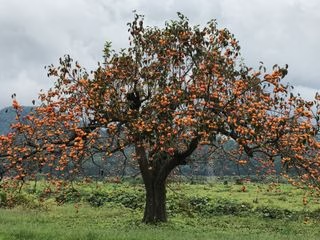Golf clubs still get described as being woods or irons, as that is what they used to be made from. To hit the longest shots, clubs with wooden heads were used. The type of wood used to make these heads varied, with beech, ash and maple all being used; but persimmon became the wood of choice. It was favoured as it was hard, tough, heavy and shock-resistant.
A plate was attached to the face of the club to provide durability and, as the glues of the time were of unreliable quality, the plates were screwed in. Even when glues improved, and plates could be glued on with more confidence, the plates were still nevertheless sometimes designed to look as if they had screws in them.
It a ball was caught right in the middle of the club, the sweetspot, it went further, and the term “hit it right out the screws”, still used today, reflects the design of those drivers.
Persimmon woods were what everyone, from top professionals to beginners, played with. Then in 1979 a chap named Gary Adams took out a $24,000 loan on his house to set up TaylorMade. He hired two employees and the three of them set about making a driver made of metal, known as the 1Metal or Pittsburgh Persimmon.
By making the clubhead metal and hollow, he could increase the size of the head and reduce the weight, which helped increase forgiveness and clubhead speed.
Ron Streck, at the 1981 Houston Open, was the first to win on the PGA Tour using a metal wood. The take up among tour professionals was quick, although some players were reluctant to move over from persimmon clubs as, although metal woods allowed players to hit the ball further, they offered less ability to shape shots.
For the average club golfer, metal woods offered plenty of attraction: not only in forgiveness, but drives with them went longer. The clubs also lasted longer. Persimmon clubs were less durable, and being made of absorbent wood, needed storing somewhere not too dry, hot or damp.
A persimmon tree with its plum-like fruits
(Image credit: Getty Images)
Late changers
But some leading pros carried on using persimmon drivers until the late 1990s. Davis Love III was one of these, writing in his 1997 book Every Shot I Take:
“I experiment with metal drivers often; I find – for me, and not necessarily for you – they go marginally longer than my wooden…
..
Click Here to Read the Full Original Article at Golf Monthly…
